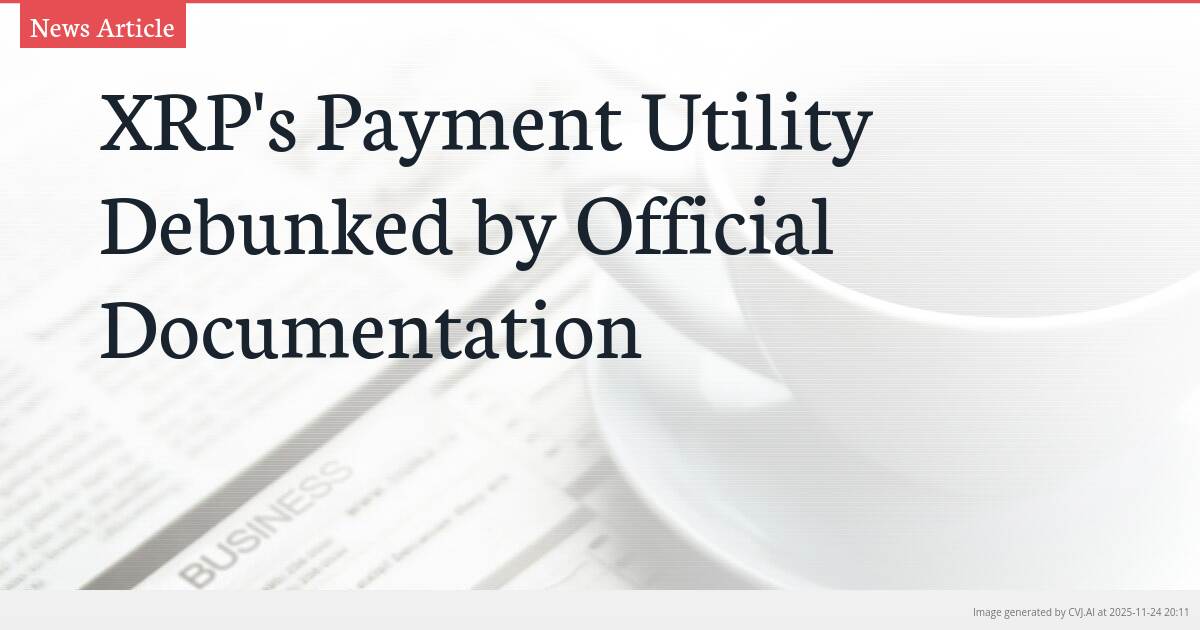Introduction
Contrary to viral claims spreading across social media, official documentation confirms XRP’s fundamental role in traditional payment systems. The digital asset was specifically engineered to enhance international money transfers and provide liquidity between currencies. Major financial institutions are already building infrastructure around XRP’s payment capabilities rather than merely experimenting.
Key Points
- XRP was specifically engineered to enhance international money transfers by serving as a neutral bridge between currencies and providing liquidity
- Over 300 banks are actively partnering with RippleNet rather than merely testing the technology, with projections of capturing 14% of SWIFT's volume by 2030
- Recent $500 million funding rounds involving major institutional players signal a shift from observation to actively building XRP-based global payment infrastructure
Documentation Reveals XRP's Payment-First Design
Recent analysis of official XRP documentation has systematically dismantled the viral narrative claiming the cryptocurrency lacks connection to traditional finance payments. According to researcher SMQKE, a basic review of the publicly available documentation reveals XRP was intentionally designed to operate within existing traditional finance systems, unlike many cryptocurrencies built purely for decentralized experimentation. The documentation clearly shows XRP was engineered specifically to address long-standing inefficiencies in the traditional payment system.
The core design philosophy positions XRP as a neutral bridge between currencies, enhancing international money transfers by providing crucial liquidity. This fundamental utility contradicts the social media narrative gaining traction online, where claims of XRP’s detachment from payment systems have spread rapidly. The documentation reinforces the asset’s payment-centric utility, showing it was created not as an experimental cryptocurrency but as a practical solution to real-world financial challenges.
Institutional Adoption Beyond Testing Phase
The conversation around RippleNet has evolved from theoretical testing to practical implementation, with crypto analyst Xfinancebull highlighting that more than 300 banks are not merely testing RippleNet but actively partnering with the technology. This represents a significant shift from experimental phase to operational deployment, indicating growing institutional confidence in XRP’s payment infrastructure. The partnerships demonstrate real-world utility being deployed at scale within the traditional banking sector.
Ripple CEO Brad Garlinghouse has provided concrete projections about XRP’s potential impact on global finance, forecasting that XRP could capture up to 14% of current SWIFT volume by 2030. This represents an estimated $21 trillion in annual value moving across the XRP Ledger infrastructure. Garlinghouse’s focus isn’t on short-term price movements but on how global financial plumbing is being re-engineered in real-time to enable banks to settle cross-border transactions instantly 24/7 with lower operational fees.
As Xfinancebull noted, “You don’t buy XRP for today. You buy it for the financial world that is coming.” This perspective highlights the divergence between retail traders reacting to price fluctuations and institutions building long-term infrastructure. While retail attention often focuses on market volatility, financial institutions are entering substantive partnerships and signing integrations that position XRP at the center of future payment systems.
Major Capital Shifts Signal Infrastructure Build-Out
A recent strategic move from Ripple has fundamentally shifted market conversations, with XFBAcademy pointing out that while banks didn’t raise $500 million to reshape the future of money, Ripple did. This substantial capital commitment indicates why the long-term outlook around XRP continues to build strength, with real utility finally being funded at the highest institutional levels. The funding represents a vote of confidence in XRP’s payment infrastructure rather than speculative trading.
The participation of major financial firms including Fortress, Citadel, Pantera, Brevan Howard, and Galaxy in simultaneous funding rounds signals a coordinated institutional move toward XRP-based infrastructure. As XFBAcademy explains, when such prominent names participate together, it’s not speculation but a clear indicator of where financial infrastructure is heading. This capital isn’t fueled by speculative propaganda but is tied to RLUSD, institutional rails, and treasury movements into on-chain assets.
This type of sophisticated capital doesn’t chase existing narratives but actively builds new ones, with experts framing these moments as genuine turning points in financial infrastructure development. The involvement of these major institutions represents the transition of the smartest money from passive observation to active funding of the new plumbing for global finance. The $500 million raise demonstrates that institutional players see XRP’s payment utility as a foundational element of future financial systems rather than a speculative asset.
📎 Source reference: newsbtc.com

